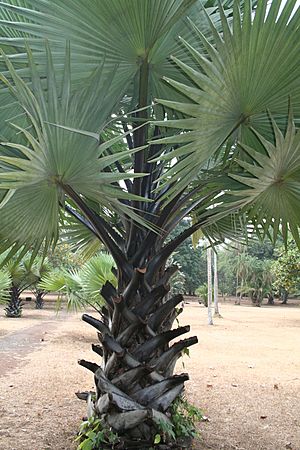Borassus aethiopum facts for kids
Quick facts for kids Borassus aethiopum |
|
|---|---|
 |
|
| Scientific classification | |
| Genus: |
Borassus
|
| Species: |
aethiopum
|
| Synonyms | |
The Borassus aethiopum is a type of palm tree found in Africa. People call it by many names, like the African fan palm, African palmyra palm, or ron palm. This tall tree grows across a large part of tropical Africa, from countries like Senegal all the way to Ethiopia. You can also find it south into northern South Africa. However, it doesn't usually grow in thick forests or very dry deserts like the Sahara and Namib. This palm also grows on the island of Madagascar and the Comoros islands.
About the African Fan Palm
The Borassus aethiopum is usually a single, tall palm tree. It can grow up to 25 meters (about 82 feet) high. That's as tall as an 8-story building! The base of its trunk can be about 1 meter (3 feet) wide.
In some river areas, like along the Rufiji River in Tanzania or the Tana River in Kenya, there's a special kind of this palm. It can be even bigger, with a trunk up to 2.1 meters (7 feet) thick. These giant palms can reach heights of 30.5 meters (100 feet).
The leaves of this palm look like large fans. They can be 3 meters (10 feet) wide, and even wider in the river areas. The stems of the leaves are about 2 meters (6.5 feet) long and have sharp spines along their edges.
Male and female flowers grow on different trees. The male flowers are small and hidden. The female flowers are much larger, about 2 centimeters (0.8 inches) wide. These female flowers grow into yellow to brown fruits. Each fruit usually has 1 to 3 seeds inside. Each seed is protected by a hard, woody shell.
How People Use This Palm
The African fan palm is very useful to people in many ways:
- Food: The fruits are safe to eat. Also, the soft roots that grow from young plants can be eaten.
- Fibers: Strong fibers can be taken from the leaves. These fibers can be used to make things like ropes or baskets.
- Wood: The wood from the tree is very strong. People say that termites, which are tiny insects that eat wood, don't like this type of wood. Because of this, the wood is often used for building houses and other structures.
See also
 In Spanish: Palmera de abanico africana para niños
In Spanish: Palmera de abanico africana para niños

